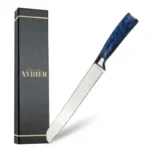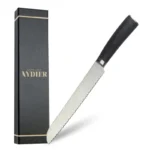Bread Knives

Bread Knife: Essential Tool for Everyday Baking and Cooking
The bread knife is one of the most practical tools you can have in your kitchen. Recognizable by its long, serrated blade, it is designed to slice through bread without crushing the loaf or tearing the soft interior. Whether you are cutting a crusty sourdough, a fluffy brioche, or a delicate sponge cake, a bread knife makes clean cuts that preserve both texture and presentation. Unlike a chef’s knife with its straight edge, the bread knife works with a sawing motion, making it especially effective for foods with a tough exterior and soft inside.
Why the Serrated Edge Matters
The defining feature of a bread knife is its serrated edge. These teeth act like small saws, gripping the crust and cutting with minimal pressure. This prevents the loaf from being squashed and keeps the slices even. The design also makes it useful for other tasks, such as slicing tomatoes, citrus fruits, or even roasts with crispy skin. A well-made serrated edge ensures you can cut through a variety of textures while maintaining control.
Choosing the Right Length and Material
Most bread knives are between 8 and 10 inches long, with 9 inches being a versatile choice for both small rolls and large artisan loaves. The length matters because it allows smooth, consistent slicing without repeated sawing. Beyond size, the choice of material influences performance and durability. Stainless steel blades are common for their resistance to rust and ease of care, while high-carbon steel offers exceptional sharpness and edge retention. Some bread knives are crafted with Damascus steel, combining strength with an attractive layered pattern.
Bread Knife vs Chef’s Knife
Although both are essential kitchen knives, they serve different purposes. A chef’s knife excels in chopping, slicing, and dicing vegetables, meat, and herbs. A bread knife, on the other hand, is specialized for sawing through crust and cutting soft interiors. Using the right knife for the right task makes food preparation faster, safer, and more precise.
Sharpening and Caring for Your Bread Knife
Caring for a bread knife extends its life and ensures it performs well over time. Unlike straight blades, serrated knives require special tools for sharpening, such as a serrated sharpener or rod that fits into each groove. Regular maintenance is simpler: hand wash after use, dry thoroughly to prevent rust, and store in a knife block, sheath, or drawer insert to protect the edge. With proper care, a bread knife can remain sharp and reliable for years.
A Must-Have in Any Kitchen
From homemade loaves to pastries and cakes, the bread knife is a versatile tool that goes beyond its name. Its serrated edge makes it one of the few knives capable of handling foods with contrasting textures without compromising quality. For home bakers and professional chefs alike, a reliable bread knife is not just an accessory but an essential part of everyday cooking.

